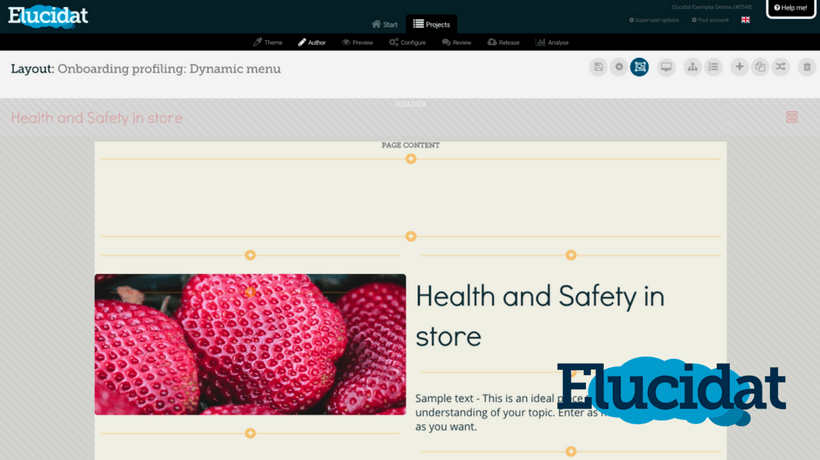Integrating Drag and Drop Interactions Into Your eLearning Course
The key to designing an eLearning course that offers the most benefit to your audience is taking them from passive observers to active participants. While there are a variety of techniques you can utilize to achieve this, one of the most effective is drag and drop interactions. However, as is the case with all eLearning strategies, you must know how to integrate them effectively in order to produce the desired outcomes and to successfully achieve your learning goals. Here are a few eLearning drag and drop interactions tips to keep in mind.
- Map out your drag and drop objects and motives beforehand.
Before you even begin the design process, you'll want to determine the motives behind the drag and drop interactions. What decisions do you want the learners to make, and which objects are you going to include? Where will the objects be on the screen, and where should they be moved to? Also, what kind of drag and drop interactions you are going to create? Are you going to include a single object that moves to a single target, or several different objects that all end up in the same target? Deciding all of these in advance will serve as a guide throughout the eLearning course design process, so that you have a clear idea of why you are creating the interaction in the first place, where it fits into your overall eLearning strategy and how you are going to integrate the activity. - Take the middle ground in regards to difficulty levels.
The goal of drag and drop interactions into your eLearning course, regardless of the subject matter, eLearning audience, or desired outcome, is to walk the fine line between being challenging and ending up frustrating. If you design drag and drop interactions that are too simple, your learners won't get any benefit from the activity; however, if they are too difficult, they will disengage from the eLearning experience, become frustrated, and won’t continue. - Don't give your learners the option to guess the correct answer.
You may want to include a few distractions that serve to steer learners away from the right answer. By doing this, you insure that they actually have an understanding of the concepts or ideas involved. For instance, by using drag and drop interactions into your eLearning course, if you give them five choices, but only allow them to choose one before the answer is graded, you can accurately assess their knowledge and performance. If they answer correctly, then you know that they have absorbed the information. If they answer incorrectly, you know that they need to work on that particular aspect of the curriculum in future eLearning sessions. The key to building these distracting answers is to make them realistic, and/or slight variants of the correct answer. Also, instead of only allowing learners to drag and drop the correct answer (as is the case with some eLearning courses), you can make all choices movable, so that learners will think twice about their decisions. - Offer your learners clear and concise instructions.
There are few things worse than spending countless hours and resources on designing amazing drag and drop interactions into your eLearning course, only to have your learners be completely confused regarding what they are supposed to do. If you have an eLearning course that is moving along at a steady pace, with the learners using navigation controls or special colors, fonts and text to make their way to the next module, throwing in drag and drop interactions interrupts this flow. As such, you will need to create clear and concise directions that highlight what is expected of them and what exactly they are supposed to do to progress. - Give your learners immediate feedback by marking the correct choice.
There are a variety of different ways in which you can provide feedback for your learners. You can make the object change color or alter its appearance altogether if it's correct or incorrect. You can place an X next to a wrong answer, or explain why the answer is not correct. Whatever method you choose, it's important to give them immediate feedback so that they can correct themselves and remember the correct solution rather than just knowing, vaguely, that they made a mistake somewhere. This can, ultimately, alter learning behaviors and give them insight into why they are making the errors, so that they can remedy the situation moving forward. - Pause to allow the learners reflect and absorb the information.
It's best to give your learners a moment to reflect upon the topic and to absorb the knowledge that is being delivered. You can do this by integrating gate screens into your design, which gives your learners more information and/or feedback about the interaction, and the core ideas or principles involved. This gives them time to regroup and register the information to their long term memory and improve their knowledge retention, while offering them the opportunity to figure out how they will apply the information in the real world. After all, that's the primary goal of any eLearning course!
By integrating drag and drop interactions into your eLearning course, you gain the ability to make it more informative and engaging for your audience. Whether you are designing for adult corporate learners or K-12 students, drag and drop interactions into your eLearning course can be customized to cater to a wide range of learning needs.
Looking for tips for visual design in your eLearning course? The article Top 5 Tips For Visual Design in eLearning offers you invaluable insight on how to create eye catching, powerful, and immersive eLearning courses, even if you are not familiar with graphic design principles.









